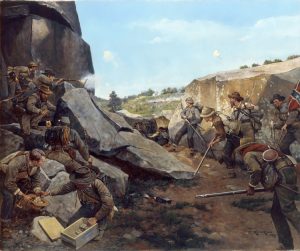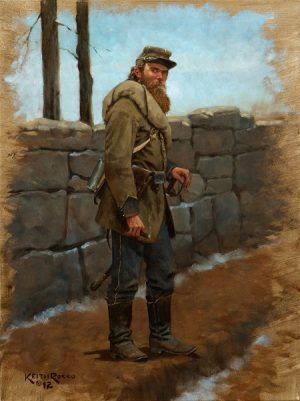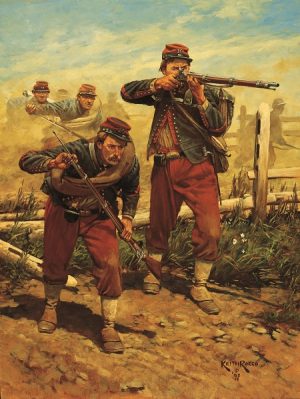50 signed and numbered prints
Confederate General James Longstreet’s corps was moving into position to make a late afternoon assault against the Union left flank in the vicinity of the rock formation known as the Devil’s Den. At about four o’clock in the afternoon, few Federal forces were present in this vicinity. The extreme left flank of Union Major General Daniel Sickles’ 3rd Corps line was being watched by one of the elite regiments of the Army of the Potomac, Colonel Hiram Berdan’s green-clad marksmen, officially the 2nd United States Sharpshooters, commanded by Major Homer R. Stoughton.
The sharpshooters had been posted on the periphery of the army all day, and earlier, the 1st U.S.S.S. had made a reconnaissance against Pitzer’s Woods, detecting the presence of a large enemy force, and engaging them in a fierce firefight. Here, the 2nd U.S.S.S. deployed in a ravine near Little Round Top. They formed a thin, extended line running perpendicular to the Emmitsburg Road, with some of the men being posted in the fields of the Slyder Farm, in the vicinity of Plum Run, to the west of Big Round Top. This skirmish line was the first line of defense against the Confederate onslaught of Major General John B. Hood’s division as it made its assault against the Union left. As the waves of butternut clad rebels advanced, they provoked a steady response of well-aimed shots by the green jackets.
At the Slyder Farm, the Vermont Sharpshooters, Companies E and H of the 2nd U.S.S.S., took position in the angle of a stone wall situated between the two story farmhouse and the barn, and opened fire upon the enemy at extreme range. As the Confederate skirmish line came closer, the firing intensified. Though they were severely outnumbered by the oncoming Confederates, the Federals’ breech loading 52 caliber Sharps rifles allowed for rapid and accurate fire. From their protective cover behind the stone wall and other favorable positions, the sharpshooters were able to harass and delay the Confederate deployment, doing “splendid execution,” in the words of their commander, even forcing one regiment to break and fall back three times. According to an officer in Brigadier General Evander M. Law’s Alabama Brigade, the Confederates ran into a “perfect hornet’s nest of sharpshooters” at the Slyder Farm.
The rebels were thus slowed, and many felt the sting of Yankee lead as they continued to advance. According sharpshooter, 1st Sergeant Wyman S. White, of Co F, “they noticed that there was some opposition to their charge for we were armed with breech loaders and, as we took the matter very coolly, many a brave Southron threw up his arms and fell.”
Ultimately, superior numbers told. The sharpshooters continued fighting until the rebels were within a hundred yards of them. They were then ordered to fall back, as their right was outflanked by the extended Confederate battle-line. Laws’ men overran the farm, trampling the crops and fields in their wake.
The sharpshooters continued to fire as they made their retrograde movement, their left wing taking position on a hillside from which they fired into the Confederate flank and rear, and taking a number of prisoners. They then retreated to the Devil’s Den and the round tops, where they would be heard from again by their Confederate adversaries during the course of the afternoon.
By Robert I. Girardi
| Medium | |
|---|---|
| Size | 18" x 24" |
| Type |



